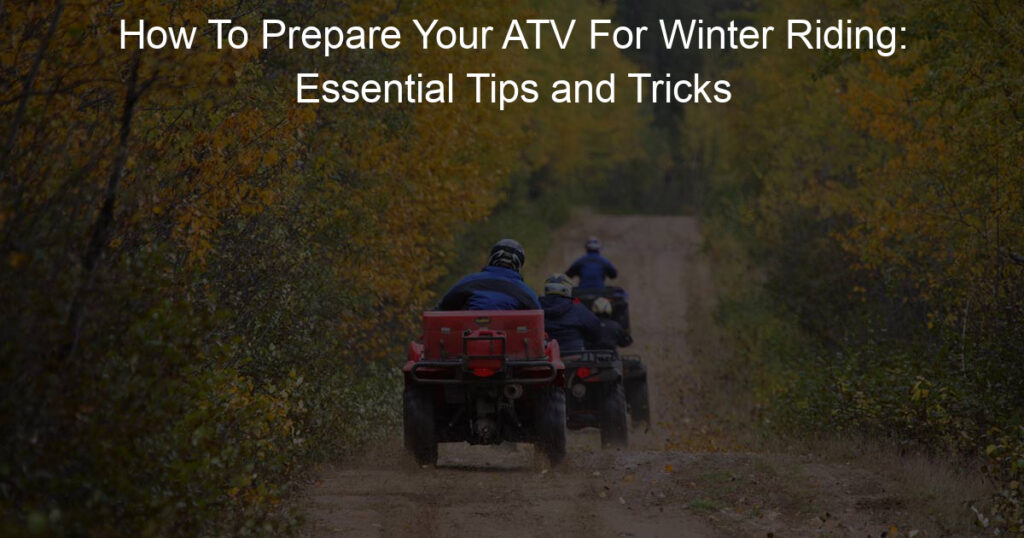As winter approaches, it’s crucial for ATV enthusiasts to prepare their vehicles for the harsh conditions that come with the season. Proper maintenance and preparation can significantly enhance your riding experience, ensure your safety, and extend the lifespan of your ATV.
How to prepare your ATV for winter riding? From pre-inspection to optimizing performance, taking the right steps will not only protect your investment but also make every winter ride enjoyable and safe.
Winterizing your ATV involves optimizing it for cold weather by taking special care of its engine, fuel system, and even tires. With fluctuating temperatures and potential exposure to snow and ice, your vehicle requires protection against extreme cold and possible damage.
Moreover, incorporating additional equipment and safety measures tailored for winter conditions is instrumental in staying safe throughout the season.
Regular maintenance and inspection of your ATV during the winter months should not be overlooked. It’s essential to stay informed about the best practices and ensure that your vehicle remains in optimal condition.
By considering the necessary precautions and being mindful of various aspects, you’ll experience a worry-free winter filled with exciting adventures on your ATV.
Key Takeaways
- Preparing your ATV for winter enhances safety, performance, and longevity
- Protecting the engine and incorporating additional equipment ensures a smooth winter ride
- Regular maintenance and inspection are crucial for a safe and enjoyable winter ATV experience
The Importance of Preparing Your ATV for Winter
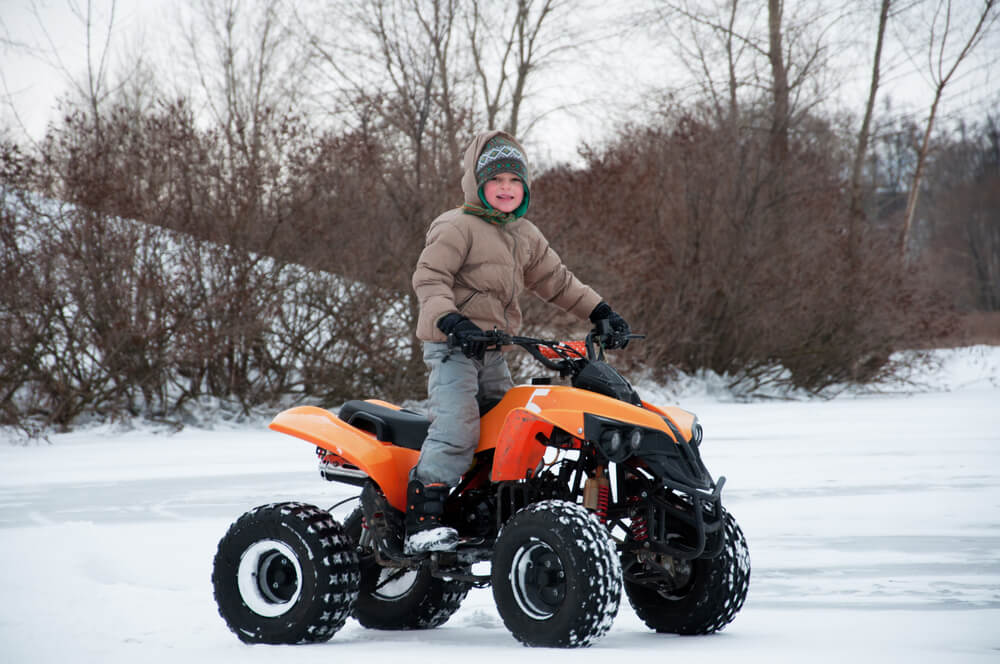
Riding your ATV during winter can be a thrilling experience, but it’s crucial to adequately prepare your vehicle for the colder season. Proper preparation helps ensure optimal performance, comfort, and safety.
This section will discuss the importance of understanding seasonal variables and learning the basics of ATV maintenance for winter riding conditions.
Understanding Seasonal Variables
Winter weather brings several challenges for ATV riders. Snow, ice, and frigid temperatures can affect your vehicle’s performance and your riding experience.
It is essential to recognize how these factors impact your ATV and modify your maintenance and preparation accordingly to ensure a smooth and safe ride.
For instance, cold weather can lead to moisture in the tank or fuel lines, affecting the engine’s performance and ability to start. Additionally, proper traction is crucial on slippery surfaces, requiring you to use appropriate tires and ensure that they’re in good condition.
Learning the Basics of ATV Maintenance
Before winter arrives, it’s important to familiarize yourself with the essential maintenance tasks for your ATV. These include changing your oil, oil filter, and air filter to ensure your engine runs smoothly during the colder season.
Adding a fuel stabilizer, such as Sta-Bil, can help prevent fuel degradation and protect your engine from possible damage.
Another critical aspect of winter maintenance is installing heating elements, like heated grips, to improve your comfort during rides. It’s also vital to keep your ATV clean and lubricated, especially the drive chain and any parts that require grease.
Understanding seasonal variables and basic ATV maintenance is the key to a safe and enjoyable winter riding experience. Proper preparation ensures your vehicle’s optimal performance and comfort during the colder months, providing you with peace of mind and a fun-filled adventure.
Pre-Inspection Before Winter Riding
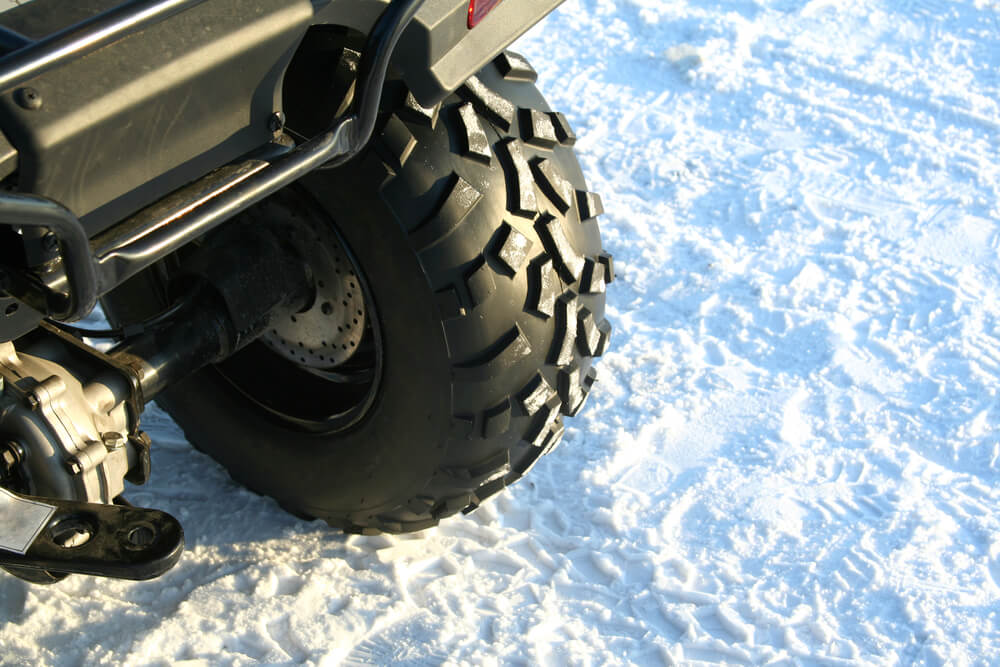
As the cold season approaches, it’s crucial to ensure your ATV is prepared for winter riding. Conducting a thorough pre-inspection can help keep your ATV in top condition and minimize potential issues that may arise.
In this section, we’ll focus on three key aspects of your pre-inspection: checking tires and wheels, examining fluids, and inspecting the brakes and lights.
Checking Tires and Wheels
Before you hit the snow-laden trails, take some time to inspect your ATV’s tires and wheels. Check for any visible damage, such as cracks, punctures, or uneven wear. Ensure there’s adequate tread, as worn-out tires might compromise traction on slippery winter terrain.
Further, confirm the tire pressure is within the manufacturer’s recommended range to optimize performance and prevent potential issues.
When it comes to wheels, look for any signs of fatigue or damage, like bent rims or missing lug nuts. It’s also a good idea to double-check that all nuts and bolts are tightened securely to maintain stability and safety during your winter rides.
Examining ATV Fluids
Proper fluid maintenance is essential in the colder months. Start by checking the quality and level of the following fluids in your ATV:
- Fuel
- Coolant
- Engine coolant
- Brake fluid
Look under the machine to ensure there is no sign of a leak. Don’t forget to contemplate using winter-blend fuel, which reduces condensation and freezing in the fuel system.
Maintaining adequate levels and quality of fluids can ensure optimal performance and reduce the risk of engine or mechanical damage.
Inspecting Brakes and Lights
Before venturing out in harsh winter conditions, you need to guarantee your ATV’s brakes are fully functional. Inspect brake pads for wear and check brake fluid levels regularly. Make sure the braking system is responsive and in good working condition.
Address any visible issues immediately, as safe stopping power is crucial when encountering icy or slippery surfaces.
Besides brakes, regular inspection of your ATV’s lights is important. Visibility tends to be lower during winter months, so functioning headlights, taillights, and brake lights are essential for riding safety.
Check for any damaged or burnt-out bulbs, damaged wiring, or loose connections. Replace or repair faulty lighting as necessary to ensure a bright and safe trail ahead.
By adhering to this pre-inspection routine, you’re taking the necessary precautions to maintain a safe and enjoyable winter ATV riding experience.
Optimizing for Winter Performance
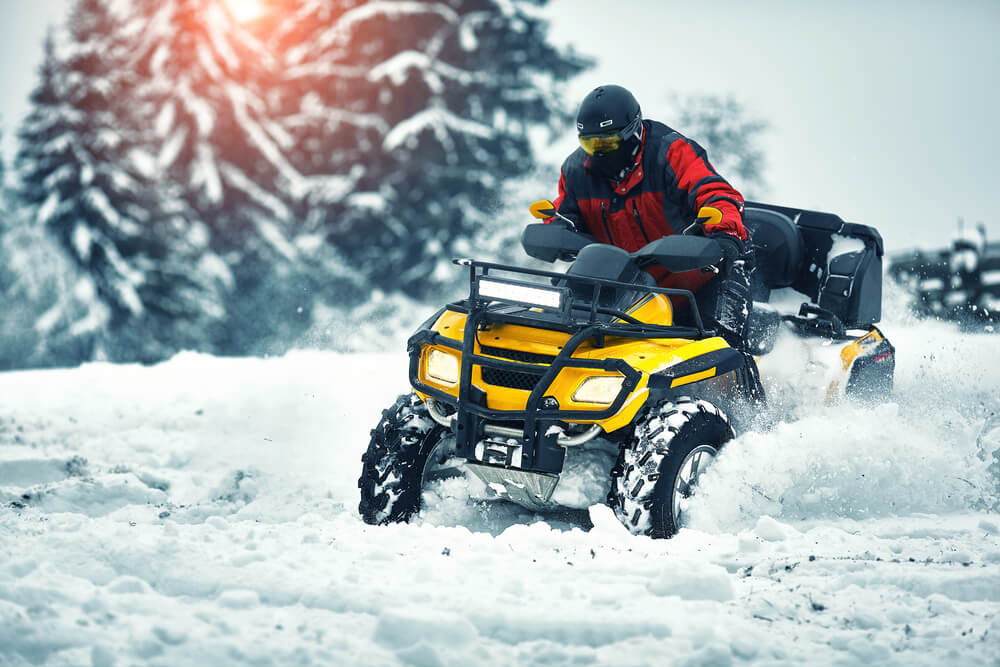
Upgrading ATV Tires
To enhance your ATV’s winter performance, consider upgrading to winter-specific ATV tires. These tires offer improved traction and durability in icy or snowy conditions due to their deeper, wider tread and flexible rubber compound.
You can find various models and sizes designed for winter use, so choose one that fits your ATV and riding preferences.
Installing Skid Plates
Another important step for preparing your ATV for winter riding is adding skid plates. These protective components prevent rocks, ice, and other debris from damaging the underside of your vehicle.
Skid plates are usually made from aluminum or plastic materials and can provide extra protection to essential areas, including:
- The engine and transmission
- The suspension components
- The front and rear differentials
Coolant and Oil Change
Before the temperature drops, it’s essential to change your ATV’s coolant and oil to ensure adequate engine protection and fluid flow during winter months. For coolant, use a product with a lower freezing point to prevent engine damage caused by frozen coolant.
Similarly, switching to a lower-viscosity engine oil improves flow in cold temperatures and minimizes engine wear.
In addition to the coolant and oil change, you should also check and replace your spark plugs if necessary. Cold weather can damage spark plugs, leading to a rough start or even preventing the engine from starting at all.
Replacing your spark plugs every few years, especially before winter, will ensure a smoother ride in cold weather.
Protecting ATV for Extreme Cold
When preparing your ATV for winter riding, it is crucial to protect it from extreme cold temperatures. This involves proper battery maintenance, fuel stabilization, and investing in an ATV cover.
Battery Maintenance
Cold weather can take a toll on your ATV’s battery. Therefore, it is essential to keep your battery fully charged and properly maintained. You can use a battery tender or a trickle charger to ensure that your battery remains in good condition during the winter months.
Additionally, you can store the battery in a warmer environment away from extreme cold when the ATV isn’t in use.
Fuel Stabilization
Preventing moisture from entering your fuel system is essential for winter ATV riding. As the temperature drops, water can condense inside the tank, causing it to mix with the fuel, and this will prevent the engine from starting.
To avoid this problem, add a fuel stabilizer to your gas tank and fill it up before storing the ATV. This will help prevent fuel deterioration, as well as moisture and water accumulation.
Invest in an ATV Cover
Investing in a high-quality ATV cover will help protect your machine from the elements, such as snow, ice, and freezing temperatures. Utilize a cover that is specifically designed for your ATV model to ensure a snug fit.
A well-fitted cover will protect the mechanical parts, the body, and the seat of your ATV, prolonging its life and ensuring its readiness for winter riding.
Additional ATV Equipment for Winter
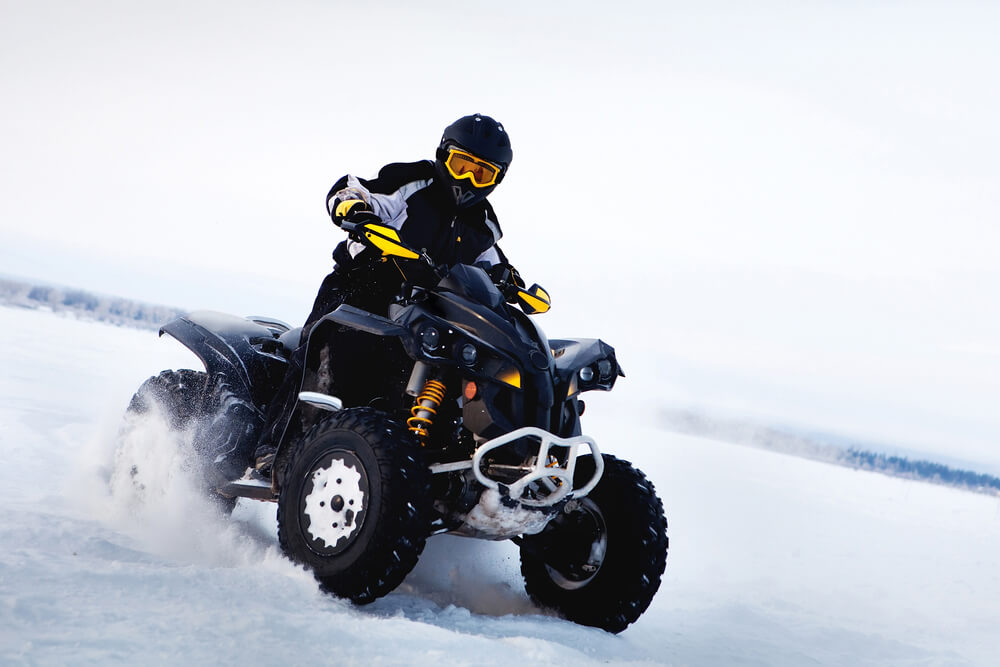
As winter approaches, it’s crucial to prepare your ATV for the season. Consider investing in additional equipment to ensure safe and enjoyable rides.
Snow Plows
A snow plow is an essential tool for winter ATV riding. It enables you to clear your way through the snow, making riding easier and safer. Snow plows come in various sizes and materials.
Choose one that suits your ATV’s size and power. Installing a snow plow will enhance your ATV’s functionality during the winter months. Make sure to check your manufacturer’s guidelines for compatibility and installation instructions.
Winches
A winch is a powerful and versatile tool for your ATV, especially during winter. You may encounter situations where your vehicle gets stuck in deep snow or slush. In such cases, a winch can be a lifesaver, allowing you to pull your ATV out of tricky spots.
Also, you can use winches to remove fallen trees or other obstacles blocking your path. Make sure you are using a suitable winch for your ATV’s weight and know how to properly operate it before venturing into snowy terrains.
Handguards and Heated Grips
Cold conditions can make it challenging to maintain a firm grip on your ATV’s handlebars. Handguards and heated grips are essential accessories to keep your hands comfortable and ensure better control.
Handguards protect your hands from cold winds and any debris, while heated grips warm your hands for a more comfortable riding experience. These accessories are easy to install and significantly improve the overall comfort and safety of your winter ATV rides.
Winter Riding Safety Measures
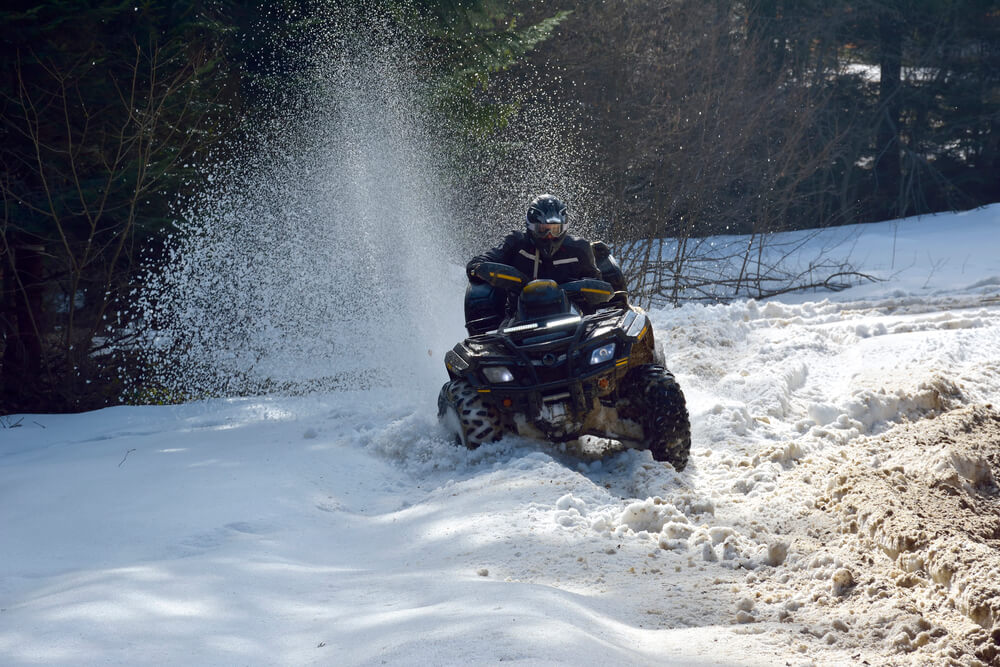
Appropriate Winter Attire
Dressing appropriately is essential for winter ATV riding. Wear multiple layers, starting with moisture-wicking base layers to keep sweat away from your body. Insulating middle layers will help retain heat, while waterproof and windproof outer layers protect you from the elements.
Don’t forget to wear a full-face helmet with a heated electric face shield to keep your face warm and visor defrosted. Furthermore, wear insulated gloves and boots to keep your hands and feet warm during your ride.
Navigating Through Snow and Ice
Snow and ice can make ATV riding more challenging. To safely navigate through these conditions, reduce your speed and avoid sudden braking. Instead, gently apply brakes and accelerate steadily to maintain control.
Remember that turning on icy surfaces requires extra caution, so lean into turns and shift your weight for better stability.
It’s also crucial to maintain your ATV’s parts well-lubricated during winter months. The cold weather can cause oil to gel, leading to clogs and wear if parts aren’t properly lubricated. Regularly check and maintain your oil levels to avoid these issues.
Riding With Others and Informing About Your Route
Riding with others and sharing your planned route is crucial for winter ATV safety. Never ride alone during winter, as potential issues like getting stuck in snow or facing mechanical problems might arise, and having a riding partner can be lifesaving.
Always inform someone about your planned route and estimated time of return, so they can initiate a search and rescue if necessary.
Wearing the right winter attire, taking proper precautions when navigating through snow and ice, and riding with others while keeping them informed about your route are essential safety measures for winter ATV riding.
Regular Maintenance and Inspection Throughout Winter
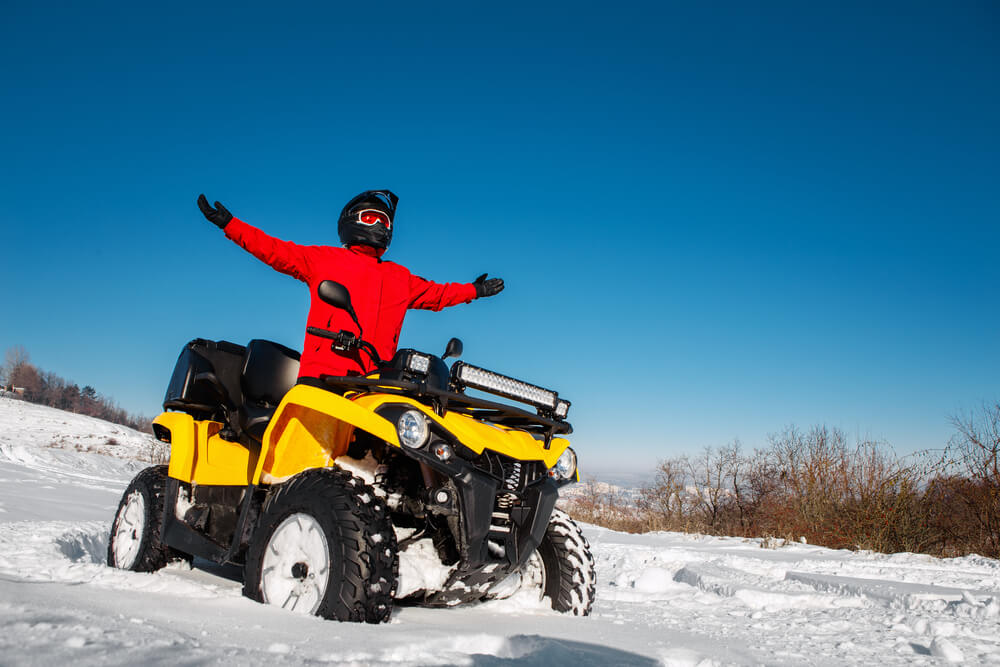
Winter riding can be tough on your ATV, so it’s essential to keep up with regular maintenance and inspections throughout the season. This will ensure that your ATV stays in top condition and prevent any issues that could potentially leave you stranded in cold weather.
Before the winter season starts, you should prepare your ATV for the harsh conditions by making sure all fluid levels are topped off, including engine oil, coolant, and brake fluid. Be sure to use the appropriate fluid types for winter, as they can differ from summer recommendations.
During the winter, it’s important to inspect your ATV regularly for any signs of wear and tear, especially on parts that come into contact with snow and ice. Check your ATV’s brakes, suspension, and tires for any damage or excessive wear.
Replace or repair any parts that show signs of potential failure. Keep an eye out for snow or ice buildup in the undercarriage and around any moving parts, as this can lead to overheating or damage.
As the temperature drops, fuel can become more susceptible to condensation. Addressing fuel temperature is crucial, as water in the fuel line might prevent the engine from starting altogether. To avoid this issue, consider using fuel additives designed for winter use, which can help prevent moisture buildup and keep your engine running smoothly.
Finally, make sure your ATV’s electrical system is working properly. The cold weather can affect your ATV’s battery, wiring, and connections, leading to potential issues such as poor performance or electrical shorts. Inspect all wiring and connections for corrosion or wear and replace damaged parts as needed. It’s also a good idea to keep your battery charged to ensure it’s ready to go when you hit the trails.
By following these regular maintenance and inspection tips, you’ll keep your ATV in prime condition throughout the winter season, ensuring a safe and enjoyable riding experience.
Frequently Asked Questions
What steps should I take to winterize my ATV?
To winterize your ATV, it’s essential to check and change the oil, inspect and clean the air filter, and replace the spark plugs if needed. Additionally, make sure you have enough coolant and consider using a fuel stabilizer to prevent fuel degradation.
How can I protect my ATV’s engine during winter riding?
Protecting your ATV’s engine in winter requires proper maintenance and the use of appropriate oil. Cold weather can cause oil to gel, potentially leading to clogs and excessive wear and tear on your engine components. Make sure to use a winter-grade oil designed for cold temperatures.
What type of tires should I use for winter ATV riding?
For winter ATV riding, it’s crucial to use tires designed for snowy and icy conditions. These tires usually have a more aggressive tread pattern and are made of softer rubber compounds that provide better traction in cold temperatures.
Look for tires specifically labeled for winter or snow use.
How do I maintain proper battery health in colder temperatures?
To maintain proper battery health during winter, ensure that your battery is fully charged before storing or riding your ATV.
Cold temperatures can affect battery performance, so regularly check the voltage and consider using a battery tender or charger to maintain optimal battery life.
What fuel additives should I consider for my ATV during winter?
During winter, consider using a fuel stabilizer or antifreeze additive in your ATV’s fuel system. These additives help prevent fuel from degrading and freezing, ensuring that your ATV starts smoothly and runs efficiently in cold temperatures.
How can I ensure my ATV’s suspension and brakes are ready for winter riding?
To prepare your ATV’s suspension and brakes for winter riding, inspect and clean the brake pads, rotors, and calipers. Additionally, check and adjust your suspension settings, taking into account the potentially slippery and uneven terrain.
Regular maintenance and inspections will ensure that your ATV’s suspension and brakes are ready for a safe and enjoyable winter riding experience.

